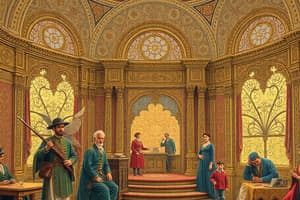Podcast
Questions and Answers
What was a significant outcome of the second Reform Bill of 1867?
What was a significant outcome of the second Reform Bill of 1867?
- It was the first Reform Bill passed in the Victorian Age.
- It allowed town workers to vote but excluded agricultural workers. (correct)
- It abolished the Poor Law of 1834.
- It granted suffrage to all workers, including miners.
Which movement was the largest organized effort by workers during the Victorian Age?
Which movement was the largest organized effort by workers during the Victorian Age?
- The Suffragette Movement
- The Poor Law Reformation
- The Chartist Movement (correct)
- The Labour Party Formation
Which significant event indicated Britain's status as a leading power during the Victorian Age?
Which significant event indicated Britain's status as a leading power during the Victorian Age?
- The Great International Exhibition of 1851 (correct)
- The formation of the Labour Party
- The establishment of the Poor Law of 1834
- The commencement of the Irish Independence Movement
What characterized the urban slums during the Victorian Age?
What characterized the urban slums during the Victorian Age?
Which of the following best describes the focus of scientific research during the Victorian Age?
Which of the following best describes the focus of scientific research during the Victorian Age?
What was a significant outcome of the Trade Union Act of 1875?
What was a significant outcome of the Trade Union Act of 1875?
Which political party was officially founded in 1900 to represent the working class in Britain?
Which political party was officially founded in 1900 to represent the working class in Britain?
What was the primary demand of Charles S. Parnell's movement for Irish independence?
What was the primary demand of Charles S. Parnell's movement for Irish independence?
Which act prohibited the employment of women and children in mines?
Which act prohibited the employment of women and children in mines?
What was one major reason for the worsening relations between Britain and Ireland during Victoria’s reign?
What was one major reason for the worsening relations between Britain and Ireland during Victoria’s reign?
Flashcards are hidden until you start studying
Study Notes
Historical Context
- The Victorian Age lasted from 1837 to 1901, marking a pivotal time of industry and social reform in Britain.
- Queen Victoria's reign began amidst political and economic challenges, influencing numerous reforms.
Political Reforms
- The first Reform Bill (1832) addressed middle-class concerns but largely ignored the working class, leading to protests.
- The Chartist Movement emerged, advocating for worker rights and suffrage.
- A second Reform Bill (1867) extended voting rights to town workers, but excluded miners and agricultural workers.
- The third Reform Bill (1884) granted universal suffrage to all male workers.
Economic Developments
- Free trade was adopted post-1846, which prevented violent revolutions in contrast to Europe in 1848.
- The Great International Exhibition (1851) showcased British industrial and scientific advancements, affirming its status as a global power.
Industrial Advancements
- The steam locomotive and extensive railway system were introduced, with major network completion by 1848.
- Regular steamboat services began in 1849, linking Britain globally.
- Scientific research transitioned to practical applications, exemplified by Samuel Morse’s telegraph invention.
Social Challenges
- The Poor Law of 1834 failed to alleviate poverty, leading to crowded workhouses likened to prisons.
- Urban slums proliferated due to rapid industrialization, highlighting the social struggles of the era.
Social Reforms
- Key social reforms included the Mines Act (1862), prohibiting employing women and children in mines.
- The 1871 Emancipation Act allowed Catholics to hold public office and attend prestigious universities.
- The Trade Union Act (1875) legalized workers' unions, which grew in influence over time.
Political Evolution
- The Conservative Party evolved from the Tories, while the Liberal Party emerged from the Whigs.
- The Labour Party was founded in 1900, representing working-class interests and gaining parliamentary representation through reforms.
British Empire and the Irish Question
- Relations with Ireland strained during Victoria’s rule, worsened by the potato famine beginning in 1845, prompting mass emigrations.
- Charles S. Parnell led the movement for Irish Home Rule, seeking self-governance.
- The British Empire expanded significantly with new territories established in Asia and the Pacific, with exports accounting for over 30% by 1914.
Imperial Politics
- During the Boer War (1854-56), many working-class volunteers joined military efforts to escape poverty.
- Britain faced high imperial defense costs, significantly higher than those of Germany or France.
- Limited independence was granted to certain colonies, laying the foundation for the modern Commonwealth post-World War II.
Studying That Suits You
Use AI to generate personalized quizzes and flashcards to suit your learning preferences.




